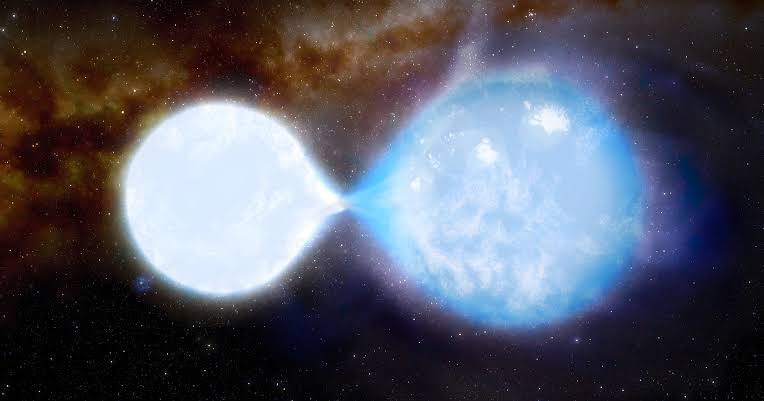The stars are in a nearby dwarf galaxy known as the Small Magellanic Cloud, and the researchers discovered that they are partially in contact, exchanging material, with one star now “feeding” off of the other. They are the most massive touching stars (also referred to as contact binaries) that have been observed, and they orbit one another every three days.
How might the collision of black holes happen?
They discovered that the best-fit model predicts that the star that is now being fed on will turn into a black hole and eat its partner star after comparing the findings of their observations with theoretical models of the development of binary systems. The remaining star will soon turn into a black hole.
These black holes will arise in just a few million years, but they will clash with enough force to cause ripples in space-time that equipment may conceivably see on Earth until after orbiting each other for billions of years.
These stars will likely merge into black holes in 18 billion years, according to our best-fit model. This study’s principal author, PhD student Matthew Rickard of UCL Physics & Astronomy, stated, “Finding stars on this evolutionary track so near to our Milky Way galaxy gives us a wonderful chance to understand even more about how these black hole binaries originate.
“This binary star is the most powerful contact binary observed so far,” said co-author Daniel Pauli, a PhD student at the University of Potsdam. “The smaller, brighter, hotter star, 32 times the mass of our Sun, is now losing material to its larger partner, 55 times the mass of our Sun.”
Pauli, the modeler, continued, “After only 200,000 years, an instant in astronomical terms, the companion star will also collapse into a black hole.” For billions of years, these two huge stars will continue to circle each other, moving round and round every few days.
“They will gradually lose this orbital energy through gravitational wave emission until they orbit each other every few seconds, eventually merging together in 18 billion years with a massive release of energy through gravitational waves.”
Comparing the results of their observations with theoretical models of binary stars’ evolution, they found that, in the best-fit model, the star that is currently being fed on will become a black hole and will feed on its companion star. The surviving star will become a black hole shortly after.
How did astronomers predict the collision?
The scientists implemented data gathered over several time periods by instruments set up on the NASA/ESA Hubble Space Telescope (HST) and the Multi-Unit Spectroscopic Explorer (MUSE) located at ESO’s Very Large Telescope (VLT) in Chile, among others, to conduct a spectroscopic analysis of the binary star, measuring various bands of light emitted by it in wavelengths ranging from ultraviolet to optical to near-infrared ranges.
Nobody has yet observed a black hole collision. However, there are many black holes in the universe, and it is not impossible for them to collide. Indeed, we have observed galaxies where two supermassive black holes move hazardously close to each other. According to theoretical theories, these black holes will spiral toward each other until they meet.
The merging black holes seen by scientists now developed billions of years ago, when the cosmos had lower quantities of iron and other heavy elements. As the cosmos has aged, the fraction of these heavy components has grown, making black hole mergers less likely. This is due to the fact that stars with a larger concentration of heavier elements have stronger winds and blow themselves apart faster.
Their spectrum research revealed that the more massive star had taken away most of the smaller star’s outer atmosphere. They also discovered that the radii of both stars surpass the Roche lobe—the region surrounding the star where matter is gravitationally bonded to it—showing that some of the material from the younger star flows over to the companion star.
Did the collision of two black holes ever get detected?
Yes. On September 14, 2015, scientists participating in the LIGO experiment heard and recorded two black holes merging for the first time in human history. The colliding black holes were 29 and 36 times the mass of the sun and were 1.3 billion light years distant, meaning that the event occurred 1.3 billion years ago.
The discovery of colliding black holes, as well as the findings of this experiment, confirmed that Einstein’s theory of relativity is valid. The LIGO experiment has so far spotted three pairs of colliding black holes.
When two supermassive black holes meet during a galaxy merger, scientists anticipate gravitational waves—disruptions in the fabric of spacetime—to be produced. Simulations show that, unlike their stellar-mass counterparts, these mergers would release both gravitational waves and radiation, the latter of which would originate in the heated, interstellar gas of the two merging galaxies disturbed by the black hole pair as they plummet towards one another.
